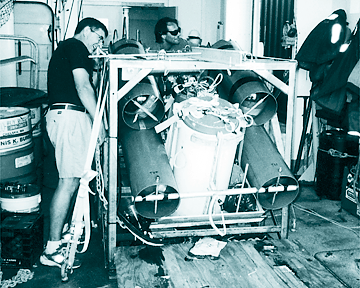


UH scientists
concoct tsunami
gauge from old
ocean cables
The only drawback to the three-
By Helen Altonn
mile-deep ocean station is getting
to it to make repairs
Star-BulletinUniversity of Hawaii scientists now have a deep ocean station allowing them to monitor any tsunami traveling here from the Aleutians.
They created the station in a tricky project with the Woods Hole Oceanographic Institute that involved attaching a package of instruments to an old telephone cable lying midway between Hawaii and California.
It's the latest of several ventures by UH geology and geophysics professor Frederick K. Duennebier to collect deep ocean seismic, pressure, current and other data.
"It is so far from land seismic stations, it is very valuable in trying to determine the structure of the Earth," he said. "We will learn a lot about tsunamis and earthquakes from this."
There's just one big hitch, which Duennebier already has encountered: "When something goes wrong, you can't drive out and turn a screw and fix it."
He said the instruments produced about 30 days' of good data until a leak occurred in one package. "It's easy to fix but it takes a ship and a Jason. It's three miles deep."
Jason is the remotely operated vehicle, or ROV, that was used with Woods Hole's submersible Alvin in finding the sunken Titanic.
Duennebier said his group built the power supply and seismic system for the deep ocean research station and Woods Hole built a junction box for the cable so more instruments could be plugged into it.
John Hutchings of Great Britain, an engineer who worked on the cable when it was installed in the 1950s, helped with the project.
"The copper is shiny as ever. It is terrific cable," Duennebier said.
Jason cut the cable on the bottom so it could be pulled onto the University of Washington ship Thomas G. Thompson.
It also pumped mud from the ocean floor to dig a hole for the instrument package, lowered in a pipe, Duennebier said. "The guys running the ROV were skeptical whether they could do it," he said. "It involved about 30 operations. They did a great job with that."
He said the hole in the ocean floor "makes for a nice quiet seismic station ... We can locate earthquakes right after they happen."
Until a suspected short in the current meter is repaired, however, only pressure data can be received to monitor tsunamis.
The data is automatically transmitted to the Makaha Cable Station, then by phone line and the Internet to UH-Manoa.
Duennebier said telephone companies gave the decommissioned cable to the Consortium of Incorporated Research Institutes for Seismology in U.S. universities.
The group monitors stations around the world and "was the big driver for one in the deep ocean," Duennebier said. "This is it."
The National Science Foundation provided more than $2 million for the project.
Duennebier hopes to get funding for another cruise in September to retrieve the instrument package and fix it.
He also needs money for a new cable between the Big Island and the Hawaii Undersea Geo-observatory, which he developed and installed by submersible two years ago on the undersea volcano Loihi.
HUGO is connected by fiber-optic cable to a recording station at Honuapo on the Big Island. Scientists were collecting a lot of earthquake, tsunami and other information about the active seamount until the cable went out last April.
Duennebier said he didn't expect the cable to survive because it isn't armored for protection against the seascape's sharp rocks and rugged terrain.
He estimates a cost of about $1 million to buy a cable and get a ship to lay it. He believes that will be done eventually because of the undersea observatory's huge potential for research.